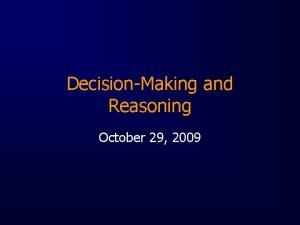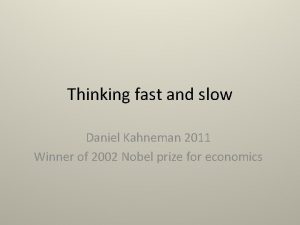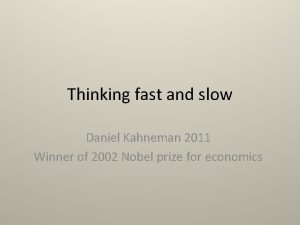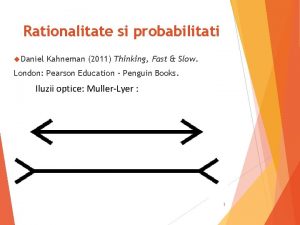Thinking DecisionMaking Kahneman Tversky The following examples are



















- Slides: 19

Thinking & Decision-Making

Kahneman & Tversky • The following examples are from the works of Danny Kahneman & Amos Tversky as related in The Undoing Project by Michael Lewis

Exercise 1 • Read the scenario and answer the question silently to yourself • Which of the following is a more likely birth order for a family with 6 kids? • Boy-Boy-Girl-Girl • Girl-Boy-Girl-Boy-Girl

Answer • They are the same

• Our minds are easily mislead by randomness • Ex. WWII London bombings • What about other, vaguer concepts?

Exercise 2 • A certain town is served by 2 hospitals. In the larger hospital about 45 babies are born each day, and in the smaller hospital about 15 babies are born each day. As you know, about 50% of all babies are boys. The exact percentage of baby boys, however, varies from day to day. Sometimes, it may be higher than 50%, sometimes, lower. • For a period of 1 year each hospital recorded the days on which more than 60% of the babies born were boys. Which hospital do you think recorded more such days? Choose one silently: • The larger hospital • The smaller hospital • About the same (w/in 5% of each other)

Answer • The smaller hospital – smaller sample size leads to likely greater variability

Heuristics • You will be given three different letters of the alphabet, and you will be asked to judge whether these letters appear more often in the first or in the third position of the word. • For example, T is in the first position of the word turbulent, and the third position in the word catch. • You will also be asked to estimate the ratio of the frequency with which they appear in these positions

Consider the letter G • Take 30 seconds and decide silently to yourself… • In English words greater than 3 letter in length, is the letter G more likely to appear in ___ the first position of a word? ___ the third position of a word? Your estimate for the ratio of these two values is ___: 1

Consider the letter R • Take 30 seconds and decide silently to yourself… • In English words greater than 3 letter in length, is the letter R more likely to appear in ___ the first position of a word? ___ the third position of a word? Your estimate for the ratio of these two values is ___: 1

Consider the letter K • Take 30 seconds and decide silently to yourself… • In English words greater than 3 letter in length, is the letter K more likely to appear in ___ the first position of a word? ___ the third position of a word? Your estimate for the ratio of these two values is ___: 1

Listen to this list of names as I read them aloud • Burak reads the names • Estimate how many male names and how many female names I read

Availability Heuristic • Our judgement can be distorted by the memorable • People aren’t stupid. We tend to use information that’s most readily available to make judgements • That does still expose us to error • It’s probably easier to think of words that start with G, R, and K but only G has more words that have G in the 1 st position than the 3 rd position • There were two more female names than male names but because the male names were more famous we can recall those more easily

Activity A • Everyone use your phone or laptop to Google “random number generator” • Change the max value to 200 • Generate a random number and write it down

• Now, you will have 5 seconds to estimate the number of African countries in the United Nations. GO! • STOP!

Activity B • Divide class into two groups • Group 2 close your eyes, Group 1 – I will give you 5 seconds to write down an estimate to the following… 8 x 7 x 6 x 5 x 4 x 3 x 2 x 1 • Now switch, Group 1 close your eyes, Group 2 – I will give you 5 seconds to write down an estimate to the following… 1 x 2 x 3 x 4 x 5 x 6 x 7 x 8

Activity C • Write down the last two digits of your address e. g. if your address is 47412, then write down 12. • Now, write that number as dollars and cents – so $1. 20 • I am now going to show you a series of items – I want you to write down the items and write your version of $1. 20 next to each item • Now write down next to each item – yes or no – would you be willing to pay exactly that amount for each item • Finally, I want you to write down the maximum amount of money you would actually be willing to spend on each item

Anchoring • These last 3 activities are designed to test the concept of anchoring • Lacking obvious information for how to assess the items in the math problem or the items you’d be willing to buy, you likely use a frame of reference based on the most recent or obvious piece of information available, even if that is somewhat arbitrary. • There are 54 African countries in the UN. Let’s crunch the numbers based on the random number generator to see if that affected the estimates. • Let’s crunch the numbers from Activity B – rationally these should be about the same, right? • I will crunch the numbers for Activity C and tell you the results on Tuesday

Summation • Reliability of judgements is subject to our experiences • To put another way, stories we concoct, rooted in our memories, replace probability judgements • “Images of the future are shaped by experience of the past” • “We often decide that an outcome is extremely unlikely or impossible, because we are unable to imagine any chain of events that could cause it to occur. The defect, often, is our imagination. ”
 Kahneman and tversky
Kahneman and tversky Survey of household economics and decisionmaking
Survey of household economics and decisionmaking Antigentest åre
Antigentest åre Daniel kahneman teoria de las perspectivas
Daniel kahneman teoria de las perspectivas Positive thinking vs negative thinking examples
Positive thinking vs negative thinking examples Thinking about your own thinking
Thinking about your own thinking Linear thinking vs holistic thinking
Linear thinking vs holistic thinking Perbedaan critical thinking dan creative thinking
Perbedaan critical thinking dan creative thinking Thinking about you thinking about me
Thinking about you thinking about me Hình ảnh bộ gõ cơ thể búng tay
Hình ảnh bộ gõ cơ thể búng tay Frameset trong html5
Frameset trong html5 Bổ thể
Bổ thể Tỉ lệ cơ thể trẻ em
Tỉ lệ cơ thể trẻ em Gấu đi như thế nào
Gấu đi như thế nào Chụp tư thế worms-breton
Chụp tư thế worms-breton Hát lên người ơi alleluia
Hát lên người ơi alleluia Kể tên các môn thể thao
Kể tên các môn thể thao Thế nào là hệ số cao nhất
Thế nào là hệ số cao nhất Các châu lục và đại dương trên thế giới
Các châu lục và đại dương trên thế giới Công của trọng lực
Công của trọng lực





































